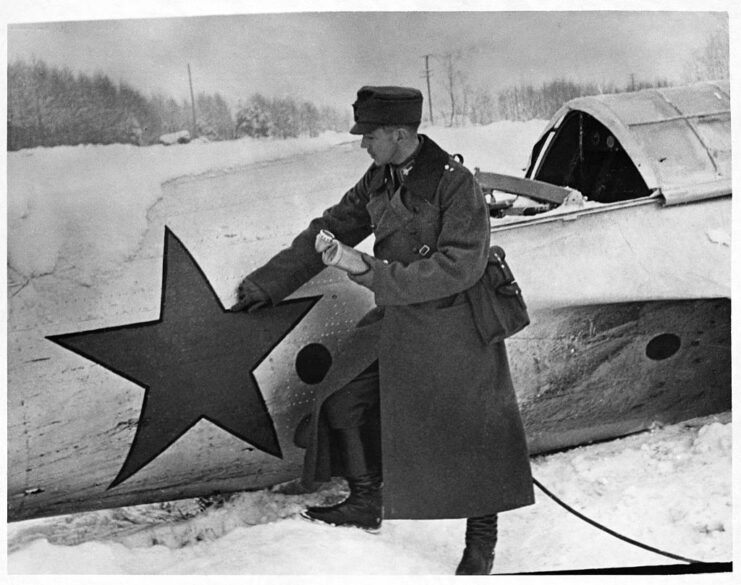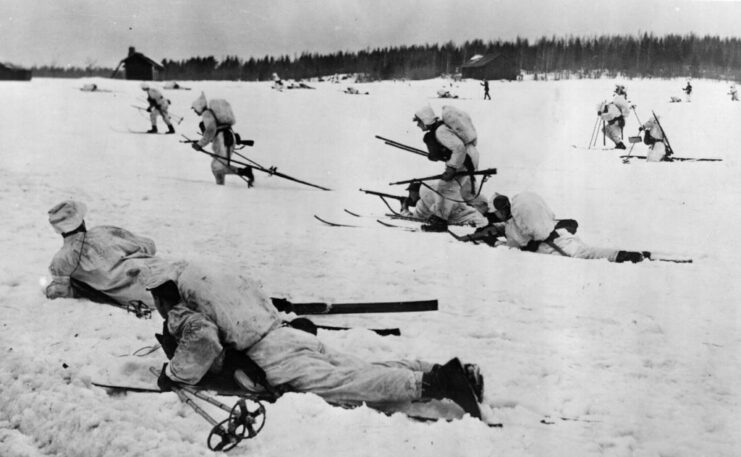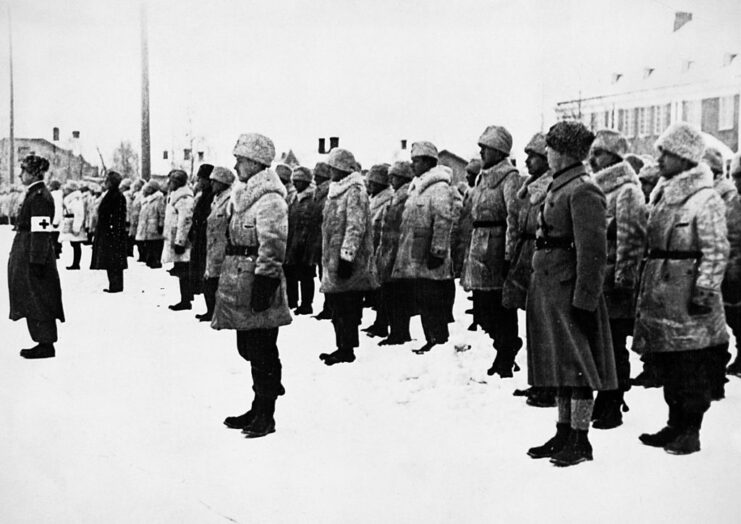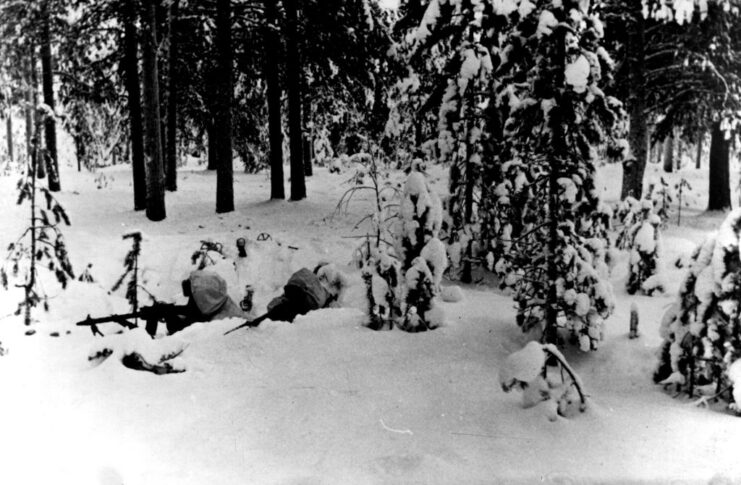As World War II was raging in Western Europe, the Soviet Union embarked on another fight, one in which its forces would easily achieve their strategic aims. However, it would also leave the Red Army bloodied and embarrassed. From November 1939, to the middle of March ’40, the Soviets fought for control of Finland, in a conflict widely known as the Winter War.
Soviet invasion of Finland

There’s a history of tension and violence between Finland and the Soviet Union. With the former’s economy growing throughout the 1930s, thanks to foreign trade, and while struggling politically, the country became a tempting target of Soviet aggression. It wasn’t long before Joseph Stalin was demanding territory from the Finns.
On November 30, 1939, having partitioned Poland with Germany, and with the rest of Europe pre-occupied with the Führer‘s forces, the USSR invaded Finland. The aim of the invasion has been disputed, but whether it was meant to end with a complete conquest or simply the rearrangement of borders, the point was clear: the Soviets were after Finnish land.
A puppet government – named the Terijoki Government – was set up in occupied territory using a few Finns who were known to be sympathetic to Soviet Communism.
Snow hindered the Soviet advance

The Russian invasion of Finland was meant to follow the blitzkrieg model that had served the Germans so well in Poland – a swift, hard-hitting advance that used superior resources and technology to overcome any resistance. However, while Poland was a land of open plains, Finland was one of frozen forests and deep snow. This was no place for a blitzkrieg approach.
Roads buried beneath 10 feet of snow blocked the Soviet advance, and ground kept warm by the snow above turned into muddy swamps, which infantrymen had to trudge through. Vehicles could only advance after hundreds of soldiers had walked through before them, stamping down the snow.
Falling victim to the cold temperatures

While familiar with fighting in their own harsh winters – the Soviet Union can be quite cold and snowy, after all – the Red Army wasn’t prepared for just how bitter the Finnish weather would be. Tents were insufficient and uniforms were not warm enough. Supply lines were breaking down and soldiers hadn’t the supplies they needed.
Ice, wind and snow made life for the invaders essentially unbearable, and things were made worse when a man became injured. Inadequately equipped for the conditions, medical services were unable to treat the wounded quickly enough, meaning most of those who were injured froze to death. Even those who were healthy risked perishing from the effects of frostbite.
Bringing the wrong types of weapons for the climate

The Soviets were prepared to fight with the most modern weapons and vehicles at their disposal, equipment they’d expected to be superior to that of the Finns. The latter were low on ammunition and had limited anti-tank weaponry and aircraft. On top of that, they had little in the way of a military, meaning that, during the Winter War, they were outnumbered one to three.
It almost seemed too easy for the Red Army – but it wasn’t.
Like the men carrying them, Soviet weapons suffered from the cold. Guns malfunctioned, engines stalled, motorized vehicles froze in the icy conditions. Even the colors of their uniforms proved counterproductive! The dark greens that would typically provide camouflage elsewhere made soldiers stand out against the bright white of the snow, making them easy targets.
Fighting Finns

The defense of Finland is a classic example of what a smaller, less well-equipped force can achieve with courage, ingenuity and knowledge of local conditions.
The Finns initially conducted a fighting retreat, giving them time to prepare their defensive lines deeper in the country. They used guerrilla tactics and skillfully concentrated troops to attack the Soviet enemy that outnumbered them. Before long, pockets of Red Army soldiers were isolated, surrounded and, then, destroyed.
Finnish tactics adapted to the weather, the enemy and the limitations of their own supplies. Troops on skis were able to move far more quickly and comfortably than the Soviet infantry, regularly outmaneuvering them. Bullets were also scavenged from fallen soldiers, helping to make up for the shortfall in supplies. On top of this, tank tracks were jammed with improvised devices to halt their advance.
The Molotov cocktail became the signature weapon of the Winter War, and it was so popular with Finnish troops that it was soon centrally manufactured.
Finland received support from its neighbors

Like the Spanish Civil War before it, the Winter War became a rallying point for opposition to what many saw as a dangerous ideology. Money and supplies were raised around the world, although a German blockade made it hard to get them through. Messages of support were sent by prominent figures in Washington, while France and Britain talked about sending their own troops into Finland.
However, it was Finland’s neighbors who helped the most. Volunteers from Sweden, Denmark, Norway, Estonia, Hungary and Ukraine came to fight alongside the Finns. Fellow Scandinavian countries, in particular, had friendly relations with Finland and feared the Soviets would invade them, too. They supplied troops familiar with the climate, men who were able to ski into battle.
Peace… But at a price

The Soviet Union had its own tactics – costly, brutal ways with which it would try to win. Flinging thousands of men into head-on assaults, the Red Army wore down the Finnish resistance and eventually breached the defensive lines. Outnumbered, outgunned and with their plans broken, the Finns were forced to seek peace.
It was a peace the Soviets were willing to accept. The Winter War had cost them hugely in terms of men, material and reputation – it was a painful embarrassment they wanted to put behind them.
Despite this, the USSR held enough Finnish territory to seek terms that suited the government. On March 12, 1940, the Moscow Peace Treaty was signed. Finland conceded nine percent of its territory and 30 percent of its economic base to the Soviet Union. As well, 422,000 Finns lost their homes.
What was learned from the Winter War?

The Soviet Union had learned a lesson from the Winter War. The Red Army re-equipped with better equipment, particularly the T-34. The Führer, watching from Germany, had also learned a lesson: the USSR was weak, and he could confidently invade and conquer the country.
More from us: D-Day Movies Every Military History Buff Needs to Watch
However, he hadn’t learned all the tactical lessons of the conflict; he failed to realize the ability of ill-equipped, but determined forces to hold back their better-equipped foes. He also didn’t acknowledge the danger of fighting in the dead of winter. The Red Army, however, took what they’d learned and applied to their own fight against Germany, allowing them to fight back along the Eastern Front.
